Dissemination events of 2022 Census results
Census on your street: IBGE publishes results with a greater level of territorial detail
March 22, 2024 03h33 PM | Last Updated: April 01, 2024 07h23 PM

This Thursday (21/3), in Florianópolis, the IBGE held the Eighth Release of the 2022 Population Census, the seventh thematic release, Aggregated Results by Preliminary Enumeration Areas – Population and Housing Units and Mesh of Preliminary Enumeration Areas. The event took place in the auditorium of the Association of Municipalities of Greater Florianópolis (Grandfpolis) and was attended by representatives of 58 public and social bodies and institutions, in addition to an audience of around 500 people who watched the event online through the Institute's official networks. The full results of the disclosure can be accessed here and the recorded event can be viewed here.
Representing the president of IBGE, the Director of Information Technology, Marcos Mazoni, thanked the state representatives for their presence and reception and spoke about the importance of improving the efficiency of surveys. "We need to think about public policies that enhance the lives of the Brazilian people. It is with great satisfaction that we are presenting the results and being able to hear from you in such a way as to enable us to improve to better understand the reality of our society and remove the shadows that inhibit conditions for public policies for those who need these surveys the most."

In the opening session, Ivone Lopes Batista, Director of Geosciences, explained the importance of the data and thanked the teams of the Institute who participated in the Census. "The enumeration areas are the operational units for data collection and operation of census data. When we look at these designs, we are looking at the most densely populated areas and where the population is moving. These data allow us to analyze the distribution of the population. Not only the satellites, but also the teams of the IBGE spread throughout the country, have allowed us to paint this portrait of the dynamics of population movement", said Ms. Batista.
The Director of Surveys, Elisabeth Hypolito, added to her appreciation a brief provocation about the purpose of the work: "We know that the Census is one of the most anticipated products because it produces municipal and intramunicipal information. Today we are releasing at an intramunicipal level. It's not enough to have a photograph, we need to have a photograph to see how we will work out improvements."

Fernando Damasco, a technician from the Department of Territorial Structures, began the presentation of the results with a historical overview of the evolution of the Mesh of Enumeration Areas every decade since 1940 up to the innovations of the 2022 Census, which for the first time brought forth a mesh developed from the collected data. "The latest results show that the population has been slowing down its growth rate, while the mesh has been on an exponential upward trend. Between 2000 and 2020, we doubled the number of enumeration areas, which reflects both technological improvements and enhancements as well as the dynamics of household production in the country and the Institute's concern to provide increasingly disaggregated, reliable levels of geographies with positional quality."
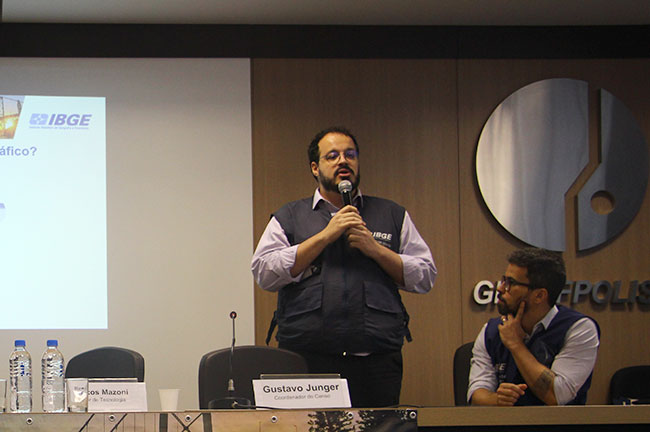
Next, Raphael Moraes, Census Technical Coordinator, presented some possibilities for the use of aggregated data of more detailed geographies by public planning managers, especially as a support for local studies and research. He exemplified with geographies other than political-administrative units, in areas of interest that could be separated through the selection of areas: the surroundings of a street, a hill (risk area), borderland strip and coastal areas, the radius from a point that could be a shop, a school, a hospital, etc.
"The main purpose of this release is to ensure that society have faster access available with more detailed information on geographies obtained from the 2022 Census, always preserving the reliability of the data. There may be discrepancies between the features, boundaries and attributes represented in the preliminary version and those of its final version," emphasized the researcher Raphael Moraes.
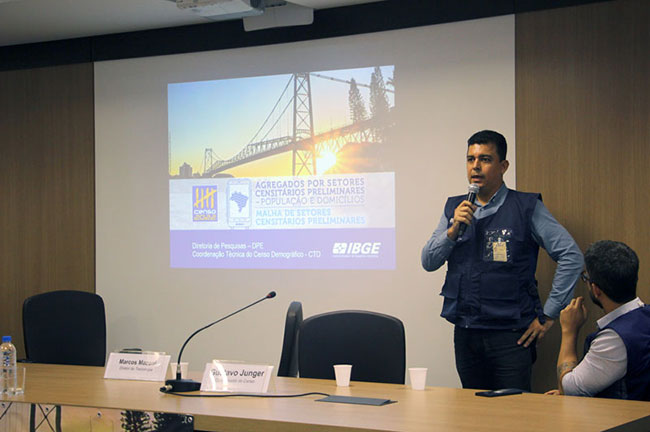
State and municipal authorities in Santa Catarina receive and validate the work of the IBGE
After the presentation, a panel made up of authorities was formed. The host, Vitor Norberto Alves, Mayor of Leoberto Leal and Vice-President of Grandfpolis, has made made himself available for future events and emphazised the partnership with the IBGE. "We are pleased to learn about the diagnosis of the municipalities to make some decisions. I have to say that my municipality is small and, in this Census, we had a decrease in the population. For a small municipality, losing 50 families reflects a lot on the economy and makes difference to the municipality, but it is from data that we also know where we need to improve.”
The Superintendent of the IBGE in the State of Santa Catarina (SC), Roberto Kern Gomes, began by saying “Seeing this crowded auditorium is an honor and shows the importance that the IBGE has for society.” He addressed few data collection figures, praised the Institute's staff and reinforced the importance of partnerships: “In SC, 15.4 thousand areas were collected by 6.7 thousand enumerators. The IBGE is on the verge of completing 88 years and we have been conducting the Census since 1940. We have expertise, you have seen the technical quality of our staff, but the Census is not carried out alone. Therefore, having the support of everyone here today is crucial. I had about 40 people to mention for their help in organization phase. The municipality of Florianópolis, for example, is heavily represented here today. If it hadn't been for the state governments and the municipality providing their classrooms during vacations, we wouldn't have been able to train all this staff. The same goes to many mayors, the military police in security matters, Cufa that helped us reach the favelas, Fecam, Grandfpolis, among many others.”
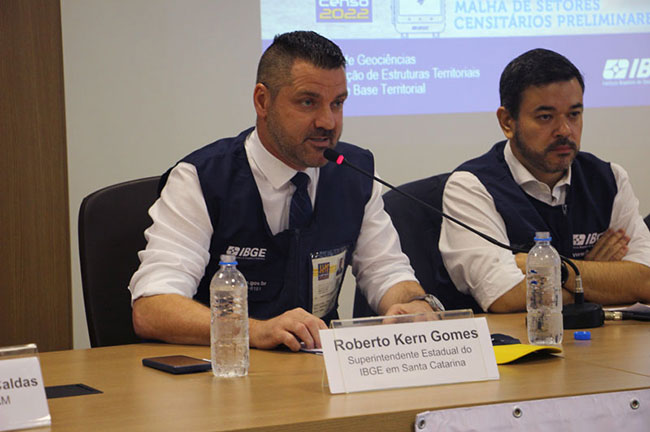
The Secretary of Planning of the State of SC, Edgard Usuy, representing the governor, began by addressing to the Director of Technology, who was representing the president of the IBGE: “Marcos, when I see Ivone, Elisabeth, Roberto and the technicians speaking, I must express my personal gratitude and on behalf of the governor of the state for your provision of such substantial material for us to carry out our work. Today, there is no room for not working with data. I understand that, regardless of party affiliation, everyone has the purpose of improving people's lives and having this so well detailed helps and drives us forward.”

The secretary continued discussing some local issues: "We are a small state, but we are the tenth largest economy in Brazil. We have the lowest unemployment rate in Brazil, a good GDP projection and we are the safest state in the country. However, in 2023, SC was the second state which received more immigrants. Where are they going, what impact will this have? We need to know what actions and public policies we should adopt to receive them. We need to think about preventive public policies to keep our data up. Finally, he also spoke about the government's concern for small municipalities and regions: "When we descend to the level of intramunicipal data, we can think about the smallest, about those that need the state's support the most."
On behalf of the Mayor of Florianópolis, the Secretary of Tourism, Zena Becker, emphasized the importance of data in the municipality's actions: “The IBGE is undoubtedly an entity with very high credibility. Not long ago, we were conducting a survey with the elderly in the downtown area, for example, where there is a large number of them, and that's why a center for elderly care was created there. When we have a real number, which the IBGE collects and provides, I have no doubt that we will increasingly succeed. Our platform is ready to receive all data and you can always count on the City Hall of Florianópolis for whatever is needed.”
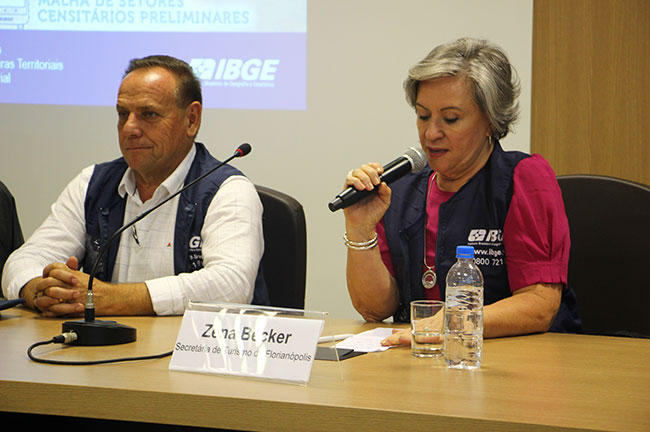
Finally, the Executive Director of FECAM Adriano Caldas concluded: "FECAM represents the 295 municipalities of Santa Catarina, and it makes me happy that the release aligns with the work that has been developed by the institution. Grandfpolis has been working on some aspects of the densification of the metropolitan area, so these data are important for us to create public policies not only for mobility but also for health and public safety. As someone who feels that belongs to this area, I would like to thank the IBGE for starting here in Grandfpolis and also Mayor Vitor for having accepted to provide the space and I would like to finish by thanking the IBGE again."
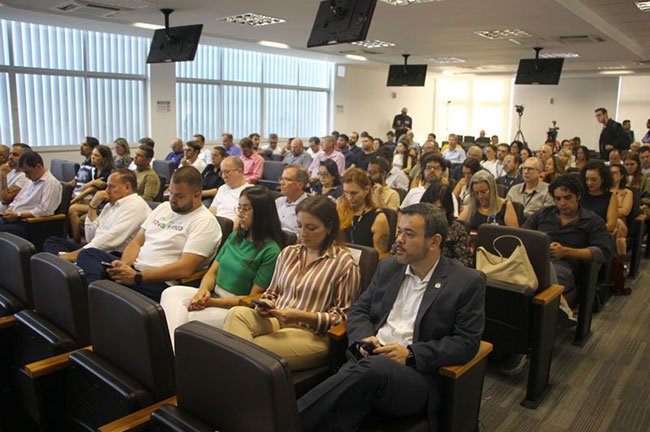
In the audience, during the whole event, were present: the State Planning Secretary, the mayors of Paulo Lopes, Leoberto Leal, Nova Trento, São Pedro de Alcantara, Garopaba, the vice-mayor of Major Gercino, the presidents of the Chambers of Rancho Queimado and São Bonifácio, the Superintendents of the Ministry of Health and SPU, councilors, the president of the Central Única das Favelas (CUFA) and representatives from the Urban Planning Institute of Florianópolis (IPUF), CDL, Military Police of SC, Crea-SC, Condominium Association Managers of SC and the Community Foundation of Greater Florianópolis (ICOM).
In addition to Granfpolis, the IBGE also partnered with the Federation of Consortiums, Associations and Municipalities of Santa Catarina (FECAM), the Federal University of Santa Catarina (UFSC), the Inter-Municipal Regulatory Agency (ARIS), as well as the Ministry of Planning and Budget and the Federal Government for the dissemination and two parallel events (External Dialogues and Digital Tools Workshop).


















